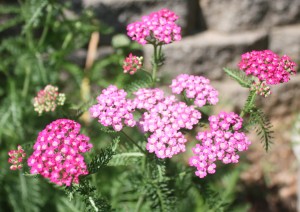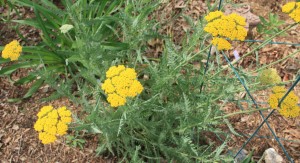Growing Yarrow is a perennial and works great in dry places with full sun. It grows in zones 3 to 10 and has showy bright flowers. The white yarrow can be found along roadsides and fields.
Yarrow fossils were found in caves which were in existence for 60,000 years. Yarrow was used to stop solders wounds with the leaves and the Native Americans used the plant for most injuries and ailments. Yarrow can be found growing wild in many areas of the US.
Medical: The medicinal yarrow has white flowers, and is rich in chemicals and great for allergic problems such as hay fever. The flowers should be harvest in the peak of their flowering cycle. The essential oil is used for anti-inflammatory and good mixed with carrier oil for chest rubs to combat colds and influenza.
The leaves of the (Achillea millefolium) encourage clotting and can be used for bleeders. When dried the plant is great used in digestive tonic to encourage bile flow in the gall bladder, and good for circulation and high blood pressure. The plant will promote sweating which may bring down a fever.
Ways of using the plant include teas, used as an inhalation, as a poultice for cuts and bruises and to increase circulation for varicose veins. The white yarrow can be made into a tincture or added to salves or your very own skin lotions. You can make your own skin lotion or added to commercial.
Just a note: Products used on the skin, I prefer to make my own because in most cases the commercial products have ingredients I can’t even pronounce.
Chew a fresh leaf to stop the pain of a toothache and drink a tea to aid in digestion. Mouthwash made with yarrow is used for inflamed gums. Yarrow is known to help cleanse the body.
In some cases yarrow can cause a skin rash and large does can cause sensitivity to sun. It should be avoided by pregnant women, actually include most herbs.
Growing: It grows about 1 foot to 2 feet tall and is considered a weed in many cases. Likes full sun but will tolerate light shade and likes a well-drained soil. Yarrow can grow in dry areas. Remove faded blooms to increase bloom time. The seed is small and tear shaped.
The plant should be divided in the fall because the roots can be invasive.
Don’t confuse Yarrow with Queen Anne lace or hemlock. Be sure and check with a field guide before picking any plants in the wild.
Culinary: The young yarrow leaves can be added to salads, or mixed in herb butter or herb cheese.
Other cultivars: The most common ornamental yarrow is yellow which is great for dry flower arrangements or adds a long living flower in the garden. Other colors of yarrow include bright pink, pastel, gold, salmon, peach and red.
Dye: The yellow flowers yield a yellow dye to wool when it is mordant with alum. The whole plant will dye an olive green when mordant is iron.
Yarrow will attract beneficial insects and likes to be grown near other herbs. The root of the plant activates a disease resistance for the nearby herbs. Cut the plant back and add to the compost pile to increase composting time. The compost pile only needs a small amount of leaves to make a pile of compost.
Yarrow looks great mix with purple cone flower and other perennials. Yarrow starts blooming usually a bit before the purple cone flower but will continue blooming as the purple cone flower bloom. Some varieties will grow lower to the ground while other stand up tall. Have fun with yarrow in your garden. It is a work worth having.
Happy Gardening!


